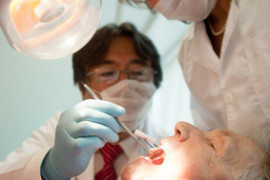At a time when healthcare costs are at the forefront of everyone’s minds, oral health will play a key role. There are dental solutions for medical problems.
A recent report from the American Dental Association showed that the number of adults visiting the dentist at least yearly has been declining over the past 7 years. As recently as 2010, it appears that more and more adults are putting off dental visits in an effort to save money. But it turns out that missing out on regular dental care bodes ill for your budget.
At the same time, research is coming out daily that shows one of the best ways to save money is to have a healthy mouth. New research from United Concordia determined that regular dental care not only improves overall health but can by extension reduce medical costs as well.
This newest study found that participants who had periodontal therapy saved an average of $1,814 from reduced hospital and office visits. The savings nearly doubled for patients with diabetes, and rheumatoid arthritis patients saved a staggering total of $3,964.
Another study in Japan examined the effect of periodontal diseases on medical and dental costs in 4,285 patients between the ages of 40 and 59 over three-and-a-half years. Researchers found that cumulative health care costs were 21% higher for those patients with severe periodontal disease than those without periodontal disease.
In the same light, oral biofilm-associated diseases surpassed heart disease as the #1 healthcare cost in 2006, according to a 2011 research article on oral biofilm-associated diseases—oral biofilm disease costs were $45 billion in 1997 and $81 billion in 2006. These costs are primarily the increased costs for diagnosis and treatment of systemic diseases caused by untreated oral disease.
Meanwhile, the Surgeon General reports that 80-85% of the population has some form of gum disease. The Center for Disease Control recently reported that over 50% have full-blown periodontal disease.
Oral inflammation is one of the top sources of inflammation in humans, and it can tip the burden on some of the inflammatory diseases that plague our society and drive up the costs of healthcare.
When you take a 30,000-foot view of our economy and healthcare, it’s simple. Seventy-five percent of U.S. health care costs are associated with lifestyle and chronic disease. Paying more attention to oral health is one of the easiest paths to lowering healthcare costs.



